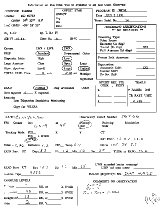



Next: 4.3 Description of SICAM1
Up: 4 Observing at GSFC
Previous: 4.1 Typical Target Acquisition
The GO specifies the desired observations on an "Observing Script"
(see Figures 4.1 and 4.2). The portion
above the dashed line must be completed by the GO before the TO can begin
target acquisition. The portion below the dashed line is completed by the TO
during acquisition.
 Figure 4.1: A typical
observing script for a blind-offset exposure. A 75 minute low-dispersion LWP
exposure was requested. The GO provided the required offset star information.
The guide star information from the exposure is provided in
the row beginning with "Tracking Mode" on the lower half of the
script.
Figure 4.1: A typical
observing script for a blind-offset exposure. A 75 minute low-dispersion LWP
exposure was requested. The GO provided the required offset star information.
The guide star information from the exposure is provided in
the row beginning with "Tracking Mode" on the lower half of the
script.
 Figure 4.2: An observing script for a
trailed exposure. A 40.8 second LWP trailed exposure was requested. This is
equivalent to a 11 second point-source exposure. Trailed exposures are always
done on gyros. Under the "Comments" heading at the bottom of the
script, the TO has noted the drift that occurred while the trail was being
performed. In this case the drift was -2 units in FES X (about 0.5 arcseconds)
and no drift in FES Y.
Figure 4.2: An observing script for a
trailed exposure. A 40.8 second LWP trailed exposure was requested. This is
equivalent to a 11 second point-source exposure. Trailed exposures are always
done on gyros. Under the "Comments" heading at the bottom of the
script, the TO has noted the drift that occurred while the trail was being
performed. In this case the drift was -2 units in FES X (about 0.5 arcseconds)
and no drift in FES Y.
At the top of the script, the observer specifies the target name, 1950
coordinates, the observer's name, program ID code, target number, desired
camera, dispersion, aperture, and exposure time. Space is provided for
the use of an offset star, offset reference points, and information for
trailed exposures.
The type of camera preparation sequence, or "prep", to be used
depends largely on the exposure level of the previous image. If the previous
image was overexposed by three or more times, an "overexposed" prep
(i.e. XSPREP) may be recommended. If the previous image was exposed
by no more than two to three times then the standard prep (SPREP) is usually
sufficient. For further discussion of the effects of overexposures, see
Section 4.6.
As discussed in Section 2.3, opening and closing of
the large aperture can cause an FES reference point shift of up to 5 arc
seconds, resulting in a miscentering of the target in the aperture. Opening
and closing of the large aperture is discouraged, therefore, except in cases of
strong scientific need.
For the LWR camera the "ping avoidance" technique may be requested.
This technique uses a 4-minute heater warm-up before the read, to reduce the
probability that LWR microphonics will contaminate your spectrum. If the 4
minute heater warm-up is not desired, circle "normal". The SWP and
LWP camera reads are always "normal". For further discussion of
microphonics and use of the warm-up technique, see Section 4.11.
Three processing types are available: point, extended, and trailed sources.
Trailed processing also applies to multiple exposures in the large aperture.
The GO may specify the spectral "registration" method (see
Appendix C) after inspecting the image. The
registration type defines the programs to be used by the Image Processing
Specialists to locate the center of the spectrum for proper extraction. For
details on image processing options and procedures, see Turnrose and Thompson (1984).
The lower half of the script completed by the TO includes the exposure start
time, read time, telescope focus, guide star position and brightness, and
related items concerning a history of precisely how the exposure was obtained.
This is often very useful to subsequent observers who may wish to repeat an
observation of the same target. In addition, it is often more efficient for the
RA to calculate the position of a faint guide star from data on an archival
script rather than to attempt to locate it with the FES at the time of
acquisition. Observing scripts for all GSFC images are available at the
observatory for GO use.




Next: 4.3 Description of SICAM1
Up: 4 Observing at GSFC
Previous: 4.1 Typical Target Acquisition
Last updated: 11 June 1997
jrc
 Figure 4.1: A typical
observing script for a blind-offset exposure. A 75 minute low-dispersion LWP
exposure was requested. The GO provided the required offset star information.
The guide star information from the exposure is provided in
the row beginning with "Tracking Mode" on the lower half of the
script.
Figure 4.1: A typical
observing script for a blind-offset exposure. A 75 minute low-dispersion LWP
exposure was requested. The GO provided the required offset star information.
The guide star information from the exposure is provided in
the row beginning with "Tracking Mode" on the lower half of the
script.